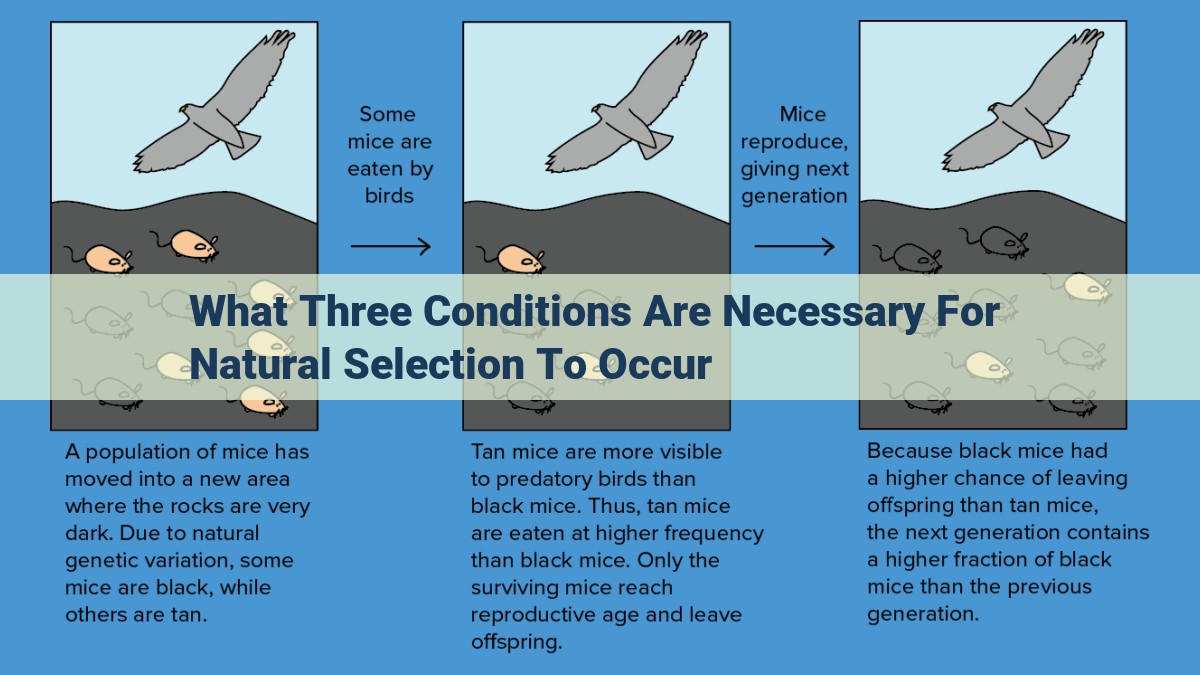Natural selection relies on three essential conditions: variation within a population (genetic differences in traits), heritable variation (transmission of traits to offspring), and differential survival and reproduction (individuals with certain traits have a higher chance of surviving and reproducing). These conditions allow favorable traits to accumulate in a population over generations, leading to adaptations and evolutionary change.
Variation Within the Population
- Define and explain variation in genotype and phenotype.
- Describe the sources of genetic variation (mutations, recombination, gene flow).
Variation Within the Population
Every living creature, from the tiniest bacteria to the towering giraffe, exhibits a remarkable diversity that sets them apart from others of their species. This variation, known as genetic variation, plays a crucial role in the evolution and survival of organisms.
At the core of genetic variation lies the concept of genotype – the specific combination of genes inherited from both parents. These genes determine the physical and biochemical traits of an organism, known as its phenotype. Variations in genotypes lead to variations in phenotypes, giving rise to the wide array of traits we observe in nature.
Genetic variation arises from three primary sources:
- Mutations: Random changes in DNA that can alter the sequence of genes.
- Recombination: The reshuffling of genetic material during sexual reproduction, creating new combinations of genes.
- Gene flow: The exchange of genetic material between populations through the movement of individuals.
Heritable Variation: The Foundation of Evolution
In the realm of genetics, heritable variation plays a pivotal role in the process of evolution. This variation refers to the differences in genetic makeup that are passed down from parents to offspring, shaping the diversity and adaptability of populations over time.
The Concept of Heritability
Heritability is a measure that quantifies the degree to which a trait is determined by genetic factors. It ranges from 0 to 1, where 0 indicates that the trait is entirely environmental and 1 signifies complete genetic control. Understanding heritability allows us to assess the potential for a trait to be passed down and its impact on future generations.
The Role of Alleles, Genes, and Chromosomes
Alleles are different forms of a gene, occupying a specific locus on a chromosome. A gene is a unit of genetic information that codes for a particular trait, such as eye color or disease susceptibility. Chromosomes, found in the nucleus of cells, carry multiple genes arranged in a precise sequence.
During reproduction, each parent contributes half of their chromosomes to their offspring, resulting in a unique combination of alleles. This process ensures that traits can be passed down from one generation to the next, generating the variation that drives evolution.
Differential Survival and Reproduction
In the grand tapestry of life, countless organisms battle for survival and the opportunity to pass on their genes. This relentless struggle, known as natural selection, is the driving force behind the evolution of life on Earth.
Natural selection operates on the principle that organisms with traits that make them better suited to their environment are more likely to survive and reproduce. Over time, these beneficial traits become more common in the population, while less advantageous traits gradually disappear.
Environmental factors play a pivotal role in natural selection. These factors, such as food availability, predator presence, and climate conditions, can determine which traits are advantageous in a particular habitat. For instance, in a lush forest where food is abundant, swiftness may not be an essential trait for survival. However, in a barren desert, where food is scarce, organisms may need to be fast and agile to catch prey or escape predators.
The concept of fitness is central to understanding natural selection. Fitness refers to an organism’s ability to survive and reproduce in its environment. Organisms with higher fitness have more offspring that survive and pass on their genes. In essence, natural selection favors individuals with traits that improve their fitness.
Through the process of differential survival and reproduction, natural selection shapes the genetic makeup of populations, leading to the evolution of new species and adaptations. Over countless generations, this relentless sorting process has resulted in the astonishing diversity of life that we observe today.
